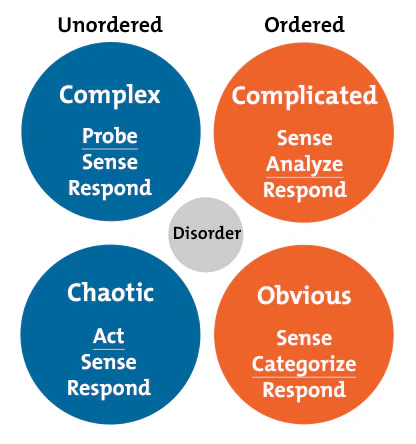- Cynefin (Kum-nifin)Framework for Problem solving models says that Problems happen in 4 contexts, Complex, Chaotic, Complicated, and Obvious, and problem solving in each context requires different actions in different orders.
Obvious Contexts – "The Domain of Best Practice"
In "obvious" contexts, your options are clear and cause-and-effect relationships are apparent to everyone involved.
Here, there are often explicit steps in place that dictate the next stage of the process. For example, problems encountered at help desks or call centers are often predictable, and there are processes in place to handle most of them.
Snowden argues that you need to "Sense – Categorize – Respond" to obvious decisions. Put simply, you should assess the situation, categorize its type, and then base your response on best practice. There is often one established "correct" answer, based on an existing process or procedure.
However, there is a danger that obvious contexts may be oversimplified. This often happens when leaders, or an entire organization, experience success and then become complacent. To avoid this, make sure that there are clear communication channels in place, so that team members can report any situations that don't fit with any established category.
Another challenge is that leaders may not be receptive to new ideas because of past experiences and success. For example, some people might automatically assume that previous solutions will work again. To overcome this, stay open to new ideas and be willing to pursue innovative suggestions.
Complicated Contexts – "The Domain of Experts"
"Complicated" problems might have several "correct" solutions. Here, there is a clear relationship between cause and effect, but it may not be visible to everyone, because the problem is... complicated. For example, you might see several symptoms of a problem but not know how to fix it.
The decision-making approach here is to "Sense – Analyze – Respond." In other words, you need to assess the situation, analyze what is known (often with the help of experts), and decide on the best response, using good practice.
Leaders may rely too heavily on experts in complicated situations, while dismissing or overlooking creative solutions from other people. To overcome this, assemble a team of people from a wide variety of background
"Complicated" problems might have several "correct" solutions. Here, there is a clear relationship between cause and effect, but it may not be visible to everyone, because the problem is... complicated. For example, you might see several symptoms of a problem but not know how to fix it.
The decision-making approach here is to "Sense – Analyze – Respond." In other words, you need to assess the situation, analyze what is known (often with the help of experts), and decide on the best response, using good practice.
Complex Contexts – "The Domain of Emergence"
It might be impossible to identify one "correct" solution, or spot cause-and-effect relationships, in "complex" situations. According to Snowden and Boone, many business situations fall into this category.
Complex contexts are often unpredictable, and the best approach here is to "Probe – Sense – Respond." Rather than trying to control the situation or insisting on a plan of action, it's often best to be patient, look for patterns, and encourage a solution to emerge.
Chaotic Contexts – "The Domain of Rapid Response"
In "chaotic" situations, no relationship between cause and effect exists, so your primary goal is to establish order and stability. Crisis and emergency scenarios often fall into this domain.
The decision-making approach here is to "Act – Sense – Respond." You need to act decisively to address the most pressing issues, sense where there is stability and where there isn't, and then respond to move the situation from chaos to complexity.
To navigate chaotic situations successfully, conduct a Risk Analysis
https://www.mindtools.com/atddimk/the-cynefin-framework

No comments:
Post a Comment